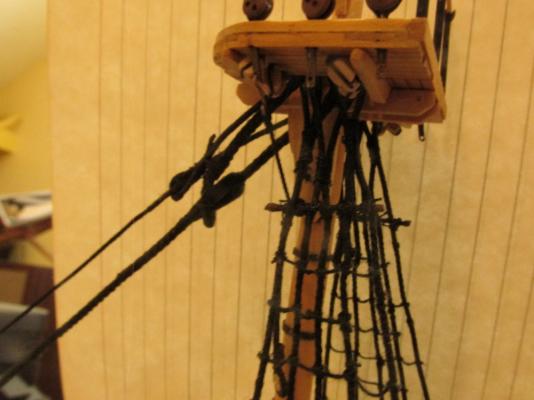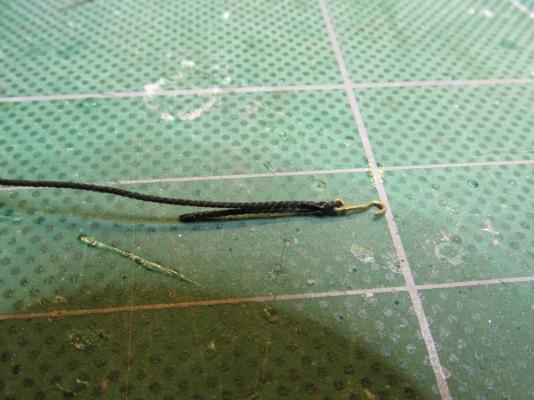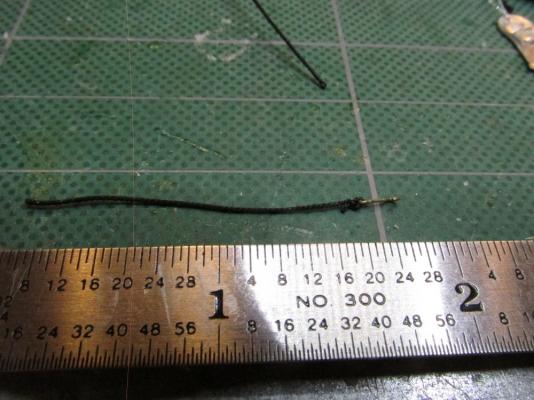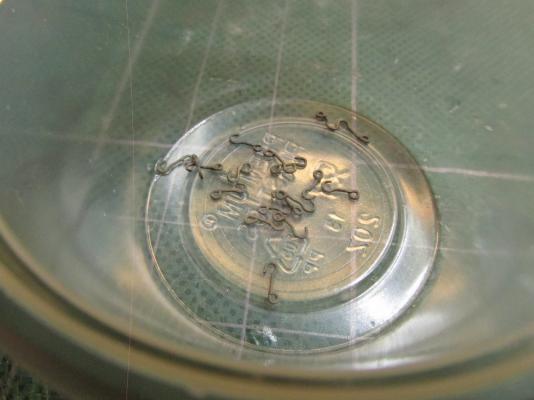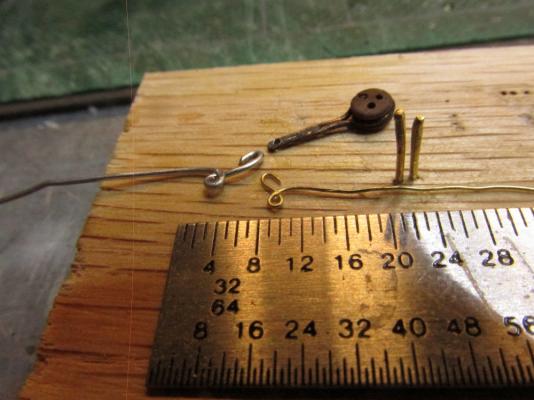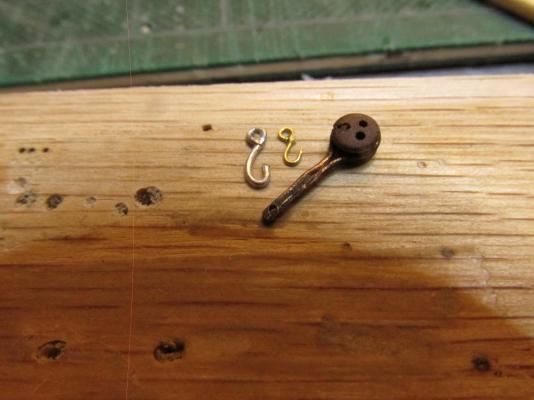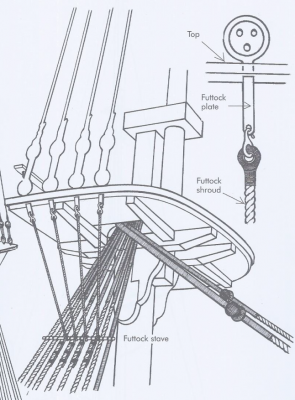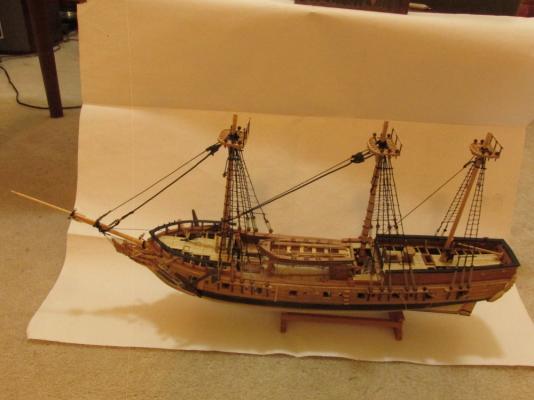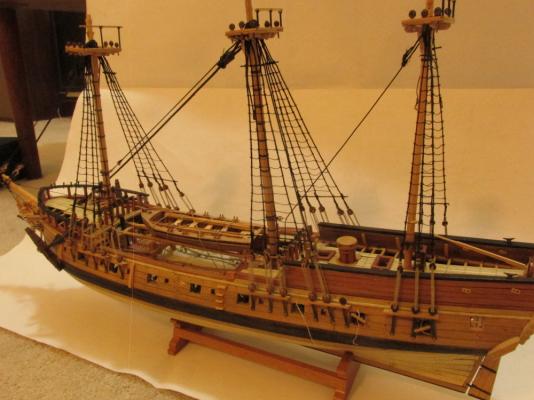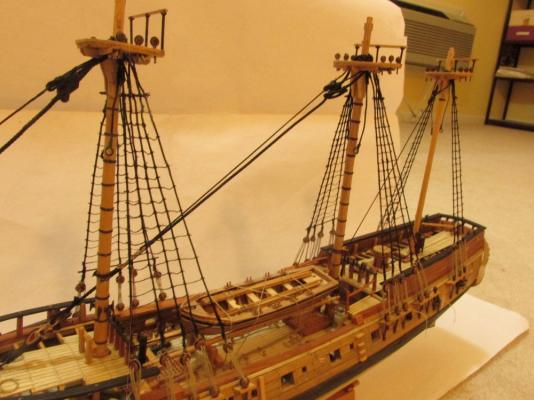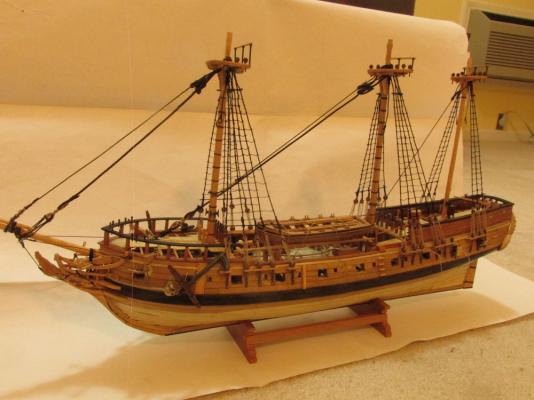-
Posts
2,583 -
Joined
-
Last visited
Content Type
Profiles
Forums
Gallery
Events
Everything posted by JSGerson
-
If the coals are hot in the oven, and there is a pot on the stove, then there has got to be something in the pot! Soup? Mush? Pot Roast?
- 572 replies
-
- constitution
- frigate
-
(and 1 more)
Tagged with:
-
I don't remember if I had the interference problem with the oar sweeps you described. but your solution would have been the same as I would have done (did?). Here is something else to consider at this point - the hull sheaves. Bob Hunt 's practicum discusses these much later (Chapter 9.7) as a simple add-on and look rather crude. I didn't even know they existed or what they were at this point in my build. However if I had known, this would have been the time to construct them or at least plan for them. Bob's method was to just drill a single hole in a small thin rectangular piece of wood and through the completed hull. This is actually a block built into the hull. It has a wide opening, a pulley wheel inside,.and is flush to the hull. Once I realized what they were, I tried to make mine at least look like they were built in. They are probably numerous ways to construct these, but one method is to drill two holes in a rectangular block whose thickness is a little bit thicker than the completed hull. The openings (both sides) are then carved to simulate a block. It is installed in the proper position in the hull frame. Once the planking is completed around it (inside and out) the excess wood is sanded down flush to the hull surface. Jon
-
Your hull sheaves look a lot more realistic than mine since mine were added after the hull planking was done. I assume you drilled holes in a piece of wood, did some carving, and inserted the piece through the hull with some support pieces. What are the problems you discovered with the stern?
- 481 replies
-
- rattlesnake
- model shipways
-
(and 1 more)
Tagged with:
-
Finally, the futtock plate is bent to the required angle and the futtock shroud is hooked on. The other end of the futtock shroud is wrapped around the stave and lashed to the shroud. The diagram shows three lashings but I used two. One down, 17 to go.
- 974 replies
-
- rattlesnake
- mamoli
-
(and 1 more)
Tagged with:
-
According to the references, the end of the futtock shroud was seized around the thimble. Since I wasn’t using a thimble I decided I would also forgo the seizing due to the scale. The seizing would have made making a small loop almost impossible Instead I used a technique I had seen described in various build log to make a pseudo eye splice and thus get the tiny splice I wanted. Basically one takes the end of the thread/rope and passes it through itself once to create the loop and a second time to create the pseudo splice and added strength. A tiny dab of glue holds it all together and then the excess thread/rope is trimmed.
- 974 replies
-
- rattlesnake
- mamoli
-
(and 1 more)
Tagged with:
-
- 974 replies
-
- rattlesnake
- mamoli
-
(and 1 more)
Tagged with:
-
The hook was made by first opening up the eyelet and then wrapping it around two tiny nails used for planking to create the shape which you can see in the first picture. After the excess wire was trimmed off, the hook then was squeezed with a pair smooth jaw plyers to flatten it and then filed smooth.
- 974 replies
-
- rattlesnake
- mamoli
-
(and 1 more)
Tagged with:
-
Then I tried using the smallest eyebolts I had - 1/16”. This appeared to work – the goldilocks zone. Here is a comparison:
- 974 replies
-
- rattlesnake
- mamoli
-
(and 1 more)
Tagged with:
-
Chuck Passaro’s Syren Ship Model Company makes very nice laser-cut plastic hooks of various sizes. Unfortunately the physical hook of his smallest version will not pass through the hole I created when I made my futtock plates. That meant I had to make my own. First I tried some aluminum wire I had for the color – too thick. Then I tried some very fine brass wire and got a beautiful hook. Too bad the wire was so pliable, a simple tug and the hook would straighten out and fall off. I didn’t dare attempt to heat temper it for fear of burning it up – too weak.
- 974 replies
-
- rattlesnake
- mamoli
-
(and 1 more)
Tagged with:
-
Futtock Shrouds The futtock shrouds is connected to the futtock plates above via a hook and lashed to the shrouds below. Normally the metal hook connects to a metal thimble seized on the end of the futtock shroud. Due to the difficulty of constructing a thimble at this scale and the ability to even see it even if it were there, I have elected not to create these thimbles. The diagram below is from Rigging Period Ship Models, by Lennarth Petersson.
- 974 replies
-
- rattlesnake
- mamoli
-
(and 1 more)
Tagged with:
-
Now that I see more of the model I recognized it as a 1797 version built by Mark Antczak at 1:48 scale. The site is at.shipmodel.com
- 1,348 replies
-
- constitution
- model shipways
-
(and 1 more)
Tagged with:
-
GLakie - Are there more images the "72" version of the 1797 config."? I'm always looking for more sources to use when I finally start my attempt at the MS Constitution model. That probably won't be be for a year or two at the rate I building the Mamoli Rattlesnake. Is that model yours? It looks gorgeous.
- 1,348 replies
-
- constitution
- model shipways
-
(and 1 more)
Tagged with:
-
Blame me, I started this whole rivet discussion.
- 572 replies
-
- constitution
- frigate
-
(and 1 more)
Tagged with:
-
Out of curiosity, do you intend to add the "rivets" which are so prominent in the ship knee photos? If so, how?
- 572 replies
-
- constitution
- frigate
-
(and 1 more)
Tagged with:
-
That's the way I did it, I had all the finesse of a blind drunken sailor with hiccups. If I knew how to do this easily, I would lock the Dremel horizontally so that the spinning disc would be downward at the point cutting. Then mount the razor blade flat on a notched piece of wood for solid support with the razor's edge flush with the wood piece's edge. The notch is where the cutting disc would engage the razor. Finally mount the razor and notch wood platform on an X-Y Table for absolute precise movement. Jon
-
Yes, I had to buy the package of mandrels as well. Those don't break so I (and probably you as well) now have a lifetime supply of mandrels. As for the discs, well...At least the razor blades are cheap. I didn't know about using hacksaw blades as an alternative. Even if I did, I didn't have any new or old ones to use. Once the scraper was made, it held up rather well although my technique of using it could have used some improvement. I did not have to replace it due to breakage or wearing out. What method of cutting the profile did you use? You may have notice if you have read further into my log, that I tried not using scrapers if I could get away with it. I just found the scraper tedious so I tried to be a little imaginative with my Dremel drill press which I detailed in the log. Let me state now that I am not a fan of the Dremel drill press. I find it too loose and imprecise. It is plastic after all, but that was and still is all I have. One of these days I'll get a real milling machine. Jon
-
In Bob Hunt practicum he points you to a company that makes very fine cutting wheels. I bought some and they cut through razor blades like butter, but they are very delicate. Breathe on them wrong and they will shatter. From other sources, people like to use old hack saw blades in lieu of razors for its rigidity. The real trick is figuring a way to manipulate the scraper so that you can cut the profile. Do you hold the blade against a fixed position spinning cutter or move the cutter while the blade is held fixed? The choice is yours. It is very important that you wear eye protection. You don't want metal shards or broken cutting discs pieces in your eye. Because I am very farsighted and wear tri-focals, I need a clip-on 3X eye loupe as well and have to get within inches of the cutting blade to see what I am doing. Then I had to make numerous trial cuts till I got something halfway decent. Once you've created the scraper, clamp it in a vise...tight. Use a piece of wood that is longer than you need and fits exactly to the width of the scraper's profile cut you made. Draw the wood strip repeatedly through the scraper. Jon
-
- 974 replies
-
- rattlesnake
- mamoli
-
(and 1 more)
Tagged with:
-
You lucky stiff! I met Chuck at the last NRG Conference in St. Louis when he demonstrated how he makes his wonderful miniature rope. What surprised most of us who witnessed the demonstration, was that he used the simple Model Expo wooden rope walk (as opposed to the Byrnes precision machined rope walk). He did modify it so that it accepts an electric drill to power it instead of a hand crank. He was willing to answer any and all questions and talk with you. Awfully nice guy. Unfortunately for me, there is no modelling club near me to help me along. Jon
- 481 replies
-
- rattlesnake
- model shipways
-
(and 1 more)
Tagged with:
-
How did you even know to order the capstan kit if Chuck hasn't yet built one himself let alone advertise it? Jon
- 481 replies
-
- rattlesnake
- model shipways
-
(and 1 more)
Tagged with:
-
I like those clamps. What method did you use to slot the oak jaws?
- 572 replies
-
- constitution
- frigate
-
(and 1 more)
Tagged with:
-
Martin - I did actual use paper clip gauges although you wouldn't know it from my results. I did everything you described...almost. The problem was that I liked seizing the deadeyes on my sizing machine. I could make them nice and tight. I would seize the first deadeye on the machine. Then holding it in place with the gauge on the model, loop the shroud over the mast to the other deadeye also attached to a gauge. A clip was placed on the looped 2nd deadeye to hold the shroud in position. Here is were it got squirrely. I removed the shroud from the model and seized the second end on the machine. I imagine due to the variances in tension, how it looped over the mast the second time in comparison to the first time, placing it on the seizing machine, etc. when finally installing the shroud, things didn't line up as intended. The deadeyes were all seized and glued at this point so I ended up with what I had. I did the best I could with the lashings. My original concern was I could not seize the shrouds insitu on the model and make it clean and tight. Well I got got clean and tight, but uneven deadeyes. I'll try your method on the next mast step. Jon
- 974 replies
-
- rattlesnake
- mamoli
-
(and 1 more)
Tagged with:
-
If I had thought about printing the name like you did, I don't know if I would have done the lettering the way I did (on a plaque). Either way works. Nice job on the capstan. Jon
- 481 replies
-
- rattlesnake
- model shipways
-
(and 1 more)
Tagged with:
About us
Modelshipworld - Advancing Ship Modeling through Research
SSL Secured
Your security is important for us so this Website is SSL-Secured
NRG Mailing Address
Nautical Research Guild
237 South Lincoln Street
Westmont IL, 60559-1917
Model Ship World ® and the MSW logo are Registered Trademarks, and belong to the Nautical Research Guild (United States Patent and Trademark Office: No. 6,929,264 & No. 6,929,274, registered Dec. 20, 2022)
Helpful Links
About the NRG
If you enjoy building ship models that are historically accurate as well as beautiful, then The Nautical Research Guild (NRG) is just right for you.
The Guild is a non-profit educational organization whose mission is to “Advance Ship Modeling Through Research”. We provide support to our members in their efforts to raise the quality of their model ships.
The Nautical Research Guild has published our world-renowned quarterly magazine, The Nautical Research Journal, since 1955. The pages of the Journal are full of articles by accomplished ship modelers who show you how they create those exquisite details on their models, and by maritime historians who show you the correct details to build. The Journal is available in both print and digital editions. Go to the NRG web site (www.thenrg.org) to download a complimentary digital copy of the Journal. The NRG also publishes plan sets, books and compilations of back issues of the Journal and the former Ships in Scale and Model Ship Builder magazines.




